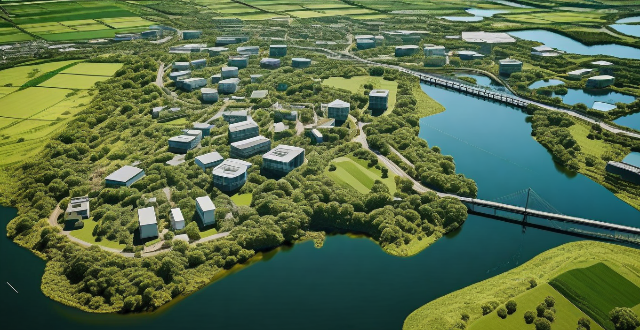Urban planning is crucial for mitigating climate change impacts on cities. Key aspects include green infrastructure, energy efficiency, sustainable transportation, and resilience to extreme weather events. Green infrastructure benefits include stormwater management, air purification, and temperature regulation. Energy-efficient strategies involve building codes, public transportation, and renewable energy use. Sustainable transportation reduces emissions, improves health, and enhances livability. Resilience strategies focus on flood protection, heat island reduction, and emergency response plans. Incorporating these elements into city designs can create more sustainable environments while reducing greenhouse gas emissions and adapting to changing climate conditions.

Urban Planning and Climate Change Mitigation
Urban planning plays a crucial role in mitigating the effects of climate change on cities. By implementing sustainable strategies, urban planners can help reduce greenhouse gas emissions, improve air quality, and enhance resilience to extreme weather events. This article will discuss the key aspects of urban planning that contribute to climate change mitigation.
Green Infrastructure
Green infrastructure refers to natural or semi-natural features that provide ecosystem services, such as stormwater management, air purification, and temperature regulation. Examples of green infrastructure include parks, green roofs, and tree-lined streets.
Benefits of Green Infrastructure
- Stormwater Management: Green infrastructure helps manage stormwater by absorbing rainfall and reducing runoff, which can prevent flooding and water pollution.
- Air Purification: Vegetation in green spaces absorbs pollutants and releases oxygen, improving air quality.
- Temperature Regulation: Green spaces provide shade and evapotranspiration, which cools the surrounding area and reduces the urban heat island effect.
Energy Efficiency
Energy efficiency is another essential aspect of urban planning for climate change mitigation. By promoting energy-efficient buildings and transportation systems, cities can significantly reduce their carbon footprint.
Strategies for Energy Efficiency
- Building Codes: Implement strict building codes that require energy-efficient designs, such as insulated walls and windows, efficient heating and cooling systems, and solar panels.
- Public Transportation: Develop an extensive public transportation network that encourages people to use buses, trains, and bikes instead of cars.
- Renewable Energy: Encourage the use of renewable energy sources, such as wind turbines and solar panels, in buildings and transportation systems.
Sustainable Transportation
Sustainable transportation is vital for reducing greenhouse gas emissions from vehicles. By promoting walking, cycling, and public transit, cities can decrease reliance on cars and improve air quality.
Benefits of Sustainable Transportation
- Reduced Emissions: Walking and cycling produce zero emissions, while public transit typically has lower emissions per passenger than cars.
- Improved Health: Active transportation modes like walking and cycling have health benefits, such as reduced obesity rates and improved cardiovascular health.
- Enhanced Livability: Sustainable transportation options make cities more livable by reducing traffic congestion, noise pollution, and air pollution.
Resilience to Extreme Weather Events
Cities must also consider the impact of extreme weather events, such as floods, hurricanes, and heatwaves, when planning for climate change mitigation. Resilient urban planning involves designing infrastructure and buildings that can withstand these events and minimize damage.
Strategies for Resilience
- Flood Protection: Develop flood protection measures, such as seawalls, levees, and floodplain restoration, to protect against rising sea levels and heavy rainfall.
- Heat Island Reduction: Implement strategies to reduce the urban heat island effect, such as increasing green spaces and using reflective materials on roofs and pavements.
- Emergency Response Plans: Create comprehensive emergency response plans that outline procedures for evacuation, sheltering, and recovery during extreme weather events.
In conclusion, urban planning plays a critical role in mitigating the effects of climate change on cities. By incorporating green infrastructure, energy efficiency, sustainable transportation, and resilience strategies into city designs, urban planners can create more sustainable, livable environments for residents while reducing greenhouse gas emissions and adapting to changing climate conditions.